Menu
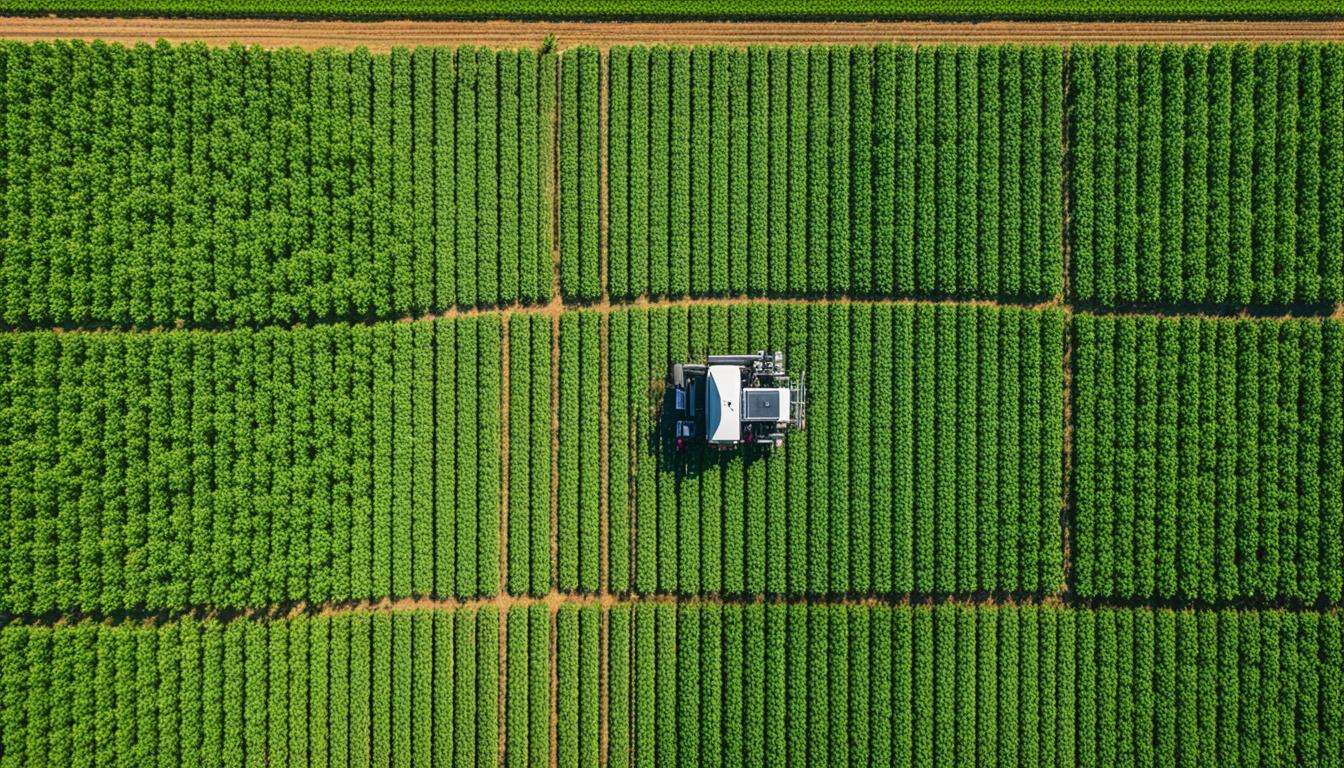
In 2024, cutting-edge farming technologies will make major strides. Drones and satellites are at the forefront. They are set to boost crop yields and cut down on waste1. This is happening as the world’s population is growing rapidly. So, the need for smart farming is huge. 2024 will see new ways to manage crops, leading to more food, eco-friendly farming, and a fresh look at producing what we eat.
Precision farming, where drones and satellites keep an eye on crops, is key. These technologies give farmers up-to-the-minute info on plant health and soil quality1. Companies like CropX and Farmers Edge are champions here, offering tools to help farmers make the best choices. Plus, there’s urban farming, like vertical farming. It uses less water and space than old-fashioned methods1. AeroFarms, for example, shines in growing food indoors, without soil1.
The CRISPR-Cas9 system is also making tweaks to crops, boosting their health and cutting the need for chemicals1. The Innovative Genomics Institute is a big name in this area. They show how changing crop genes can be a game-changer for agriculture.
Aquaponics and hydroponics are reimagining how fish and plants help each other grow. They make farming sustainable without soil, by reusing nutrients smartly1. Gotham Greens is a prime example, showing how to farm sustainably all year long.
Then there’s AI and robots, which are turning farming upside down. They predict how much we’ll grow, keep pests in check, and lower the need for harmful chemicals with their clever gadgets1. Smart farming, as said by Farmer Patsy from Countrywide Farmers, is the way forward. It not only increases what we harvest but also makes sure we farm in a way that’s kind to our planet for those who come after us.
The year 2024 brings many new farming methods. These are needed to feed the world’s growing population. Technologies like AI and machine learning are essential. They boost productivity and improve how we use resources. Precision farming is key today. It ensures the best use of land and resources, making farming smarter2.
Agricultural ERP systems are now a must-have for farm managers. They help with planning, managing finances, and keeping track of supplies. This technology is making farms more efficient and sustainable. It is also helping farmers make better financial decisions.
Good preparation of the soil before sowing seeds is critical. Seeds should be sown at a depth of 1.5 to 2.0 inches. This ensures they germinate well with enough water3. Fertilisation is another key step. It involves spreading nutrients on fields. This is done according to the crop being grown and the condition of the soil2.
Additionally, smart farming uses methods that are safe and cheaper for controlling pests. These include mechanical, biological, and chemical methods. Such an approach is called integrated pest management (IPM)3.
“As an advocate for leveraging technology in agriculture, I believe that integrating AI and precision agriculture systems will revolutionise how we approach farming in the years to come,” remarks Farmer Patsy.
Getting water to plants efficiently is a major goal for farmers. New methods like micro-sprinklers and drip systems use less water. They are better than old ways like flood irrigation3.
Timing the harvest is also important. Bad weather can lower yields if crops are not harvested quickly. Storing crops right after harvest is crucial too. Moisture levels must be just right to prevent spoilage and pests3.
Precision farming also means looking after local pests well. Choosing the right plants and watering them correctly is crucial. It prevents issues like salinity that can harm yields. Keeping weeds under control is part of this too. Farmers use soil-friendly tools and herbicides when necessary2.
Innovative farming isn’t just about technology. It also means using clever planting designs and keeping farms clean. These things help cut down on pests and diseases. Expert systems provide tips based on computer models. They guide farmers on when to water, fertilise, and more2.
So, smart farming in 2024 combines the best of old and new. It aims for farms that are both eco-friendly and highly productive. With technology and experience, farmers are making bigger, better harvests.
Precision agriculture is changing how we farm today, using smart techniques to get better crops while being kind to the planet. It relies on data and high-tech tools like sensors and images from space to manage fields well. So far, only 27 percent of farms in the U.S. have started using these methods, according to the USDA4.
“Precision agriculture is a game-changer for the industry,” says Farmer Patsy. “Using high-tech tools could make us more money and help the environment.”
Big sums of money have been put into research by the USDA and the NSF, nearly $200 million between 2017 and 2021. This has helped research centres work on the latest in artificial intelligence for farming4. The interest in improving farming has been clear, with many articles about precision farming from 2003 to 20215.
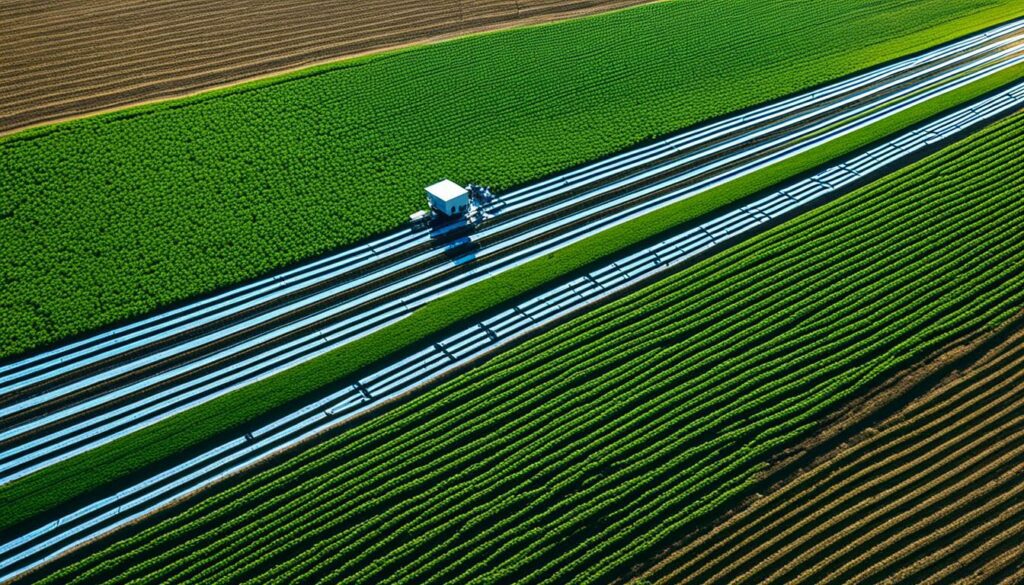
However, there are challenges to using precision farming. Costs for the tech, worries about who owns the farming data, and not having set rules are all problems4. Making farming more productive and efficient using precision farming was key for the European Commission’s CAP strategy from 2014 to 20205.
To help farms use these smart methods, experts are looking at different ways. This includes supporting farmers financially, creating better digital tools, and agreeing on how to handle farming data. For example, there’s a lot of interest in using smart watering systems that learn from data and use the internet to connect, aiming to grow more crops from 2017 to 2021. Precision agriculture is not just about improving how we run farms; it aims to change farming itself, making it smarter and friendlier to the environment.
| Key Challenges | Potential Solutions |
|---|---|
| High Acquisition Costs | Additional Financial Support |
| Data Sharing and Ownership Concerns | Enhanced Data Governance Frameworks |
| Lack of Uniform Standards | Promotion of Standardised Data Protocols |
In cities where space is a premium and farming land is running out, vertical farming offers a smart answer. It uses up instead of spreading out, making the most of every tight spot. This kind of farming is mainly done indoors, often in places like old buildings6. It doesn’t use soil and needs less water, about 70% less than the usual way of farming6. Some farms even water plants by misting their roots, using up to 90% less water6
Vertical farming can grow as much food on a single indoor acre as over 30 acres of regular farmland. This is great news for cities running short on space. It saves water and protects the soil, making it better for the planet7. By adding more plants in cities, it can also help cut the amount of climate-changing gases in the air7. Raised by Farmer Patsy, this is what I say, “Vertical farming helps make our cities greener and healthier, and it’s a way to grow food that won’t run out.”
Several companies are at the cutting edge of vertical farming. AeroFarms, based in New Jersey, leads the way with the largest US vertical farm. They use special systems to grow food without soil, inside, and in a way that saves a lot of water. This is important for feeding people in cities without harming the planet. Other companies make farms out of shipping containers, showing that farm space can really be anywhere in the city6. Money going into farming in cities is going up, showing that people believe in its future7.
In short, vertical farming is changing how we think about growing food in cities. It uses space well, saves on water, and depends on smart tech. With leaders like AeroFarms, the final outlook for city farming is good. It promises more green spaces in our cities and security in our food supply.
| Aspect | Statistics |
|---|---|
| Water Usage in Hydroponics | 70% less than traditional farming6 |
| Water Efficiency of Aeroponics | Up to 90% less water than hydroponics6 |
| Land Efficiency | Equivalent to over 30 acres of farmland per indoor acre6 |
| Urban Investment | Rising trend in urban agriculture projects7 |
| Carbon Sequestration | Reduces greenhouse gas emissions7 |
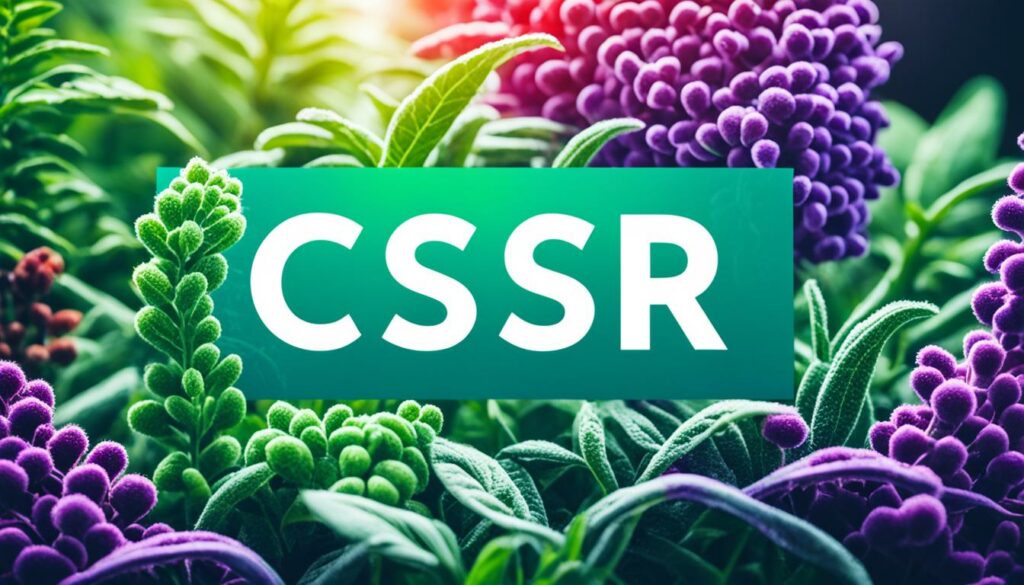
CRISPR is super precise in editing genes. It can make crops have better taste, resist drought, or fight off diseases. This precision means we could use fewer chemicals on crops, helping the environment8. “CRISPR means we can make farming better for the planet and for us,” says Farmer Patsy.
CRISPR also brings big ethical questions. Some worry about changing the very nature of crops. China’s unclear rules on gene-edited plants add to the global hesitation9. But, a lot of the science comes from Chinese work, showing their big effort in this area9. We need to carefully think about how we use gene editing in farming, balancing its benefits with the big ethical questions.
Aquaponics and hydroponics are changing the game in sustainable farming. They combine fish farming with growing plants. As a farming expert at Countrywide Farmers, I’ve seen how these methods make farming better.
In aquaponics, fish waste feeds the crops. It works in a closed system, using 90% less water than farming uses. That’s amazing for places where water is scarce. Also, it can grow up to 10 times more food on the same land10.
This technique can produce food all year round. It’s great for providing fresh produce anytime. Many cities use aquaponics because it saves space, helping people in cramped areas get food10.
Hydroponics grows plants without soil. It feeds plants directly through water, keeping the nutrients just right. This way, it’s sure the plants get all they need for good growth11.
Unlike soil farming, hydroponics doesn’t mess up the earth. It keeps the environment clean and needs less space. This is key for farming in crowded cities10.
Aquaponics and hydroponics are the future of farming. They use less water and space but produce more food. These methods are ready for the challenges of tomorrow’s farming.
| Technique | Water Use | Yield Increase | Environmental Impact |
|---|---|---|---|
| Aquaponics | -90% compared to traditional farming12 | Up to 10x more than soil-based agriculture10 | Reduces soil degradation and promotes organic practices10 |
| Hydroponics | Significantly less than traditional farming10 | Optimal nutrient uptake with DWC techniques11 | Uses controlled nutrient solutions, reducing pollution risks |
In today’s farming world, ERP systems make farm work much more organised. They link everything from planting to selling under one system. This helps farms run better by using resources well and making things smoother13. These systems cover lots of things like planning, keeping track of what’s grown, how things are sent to market, money matters, and following rules. They are key to working efficiently13.
The heart of these systems is software for farm management. It uses tools like GPS for machines and smart advice systems. These tools are key for doing things better, cutting waste, and getting more crops, which is what smart farming needs13. This system lets farms use things like drones and pictures from space smarter. It helps do more with less and have greener fields13.
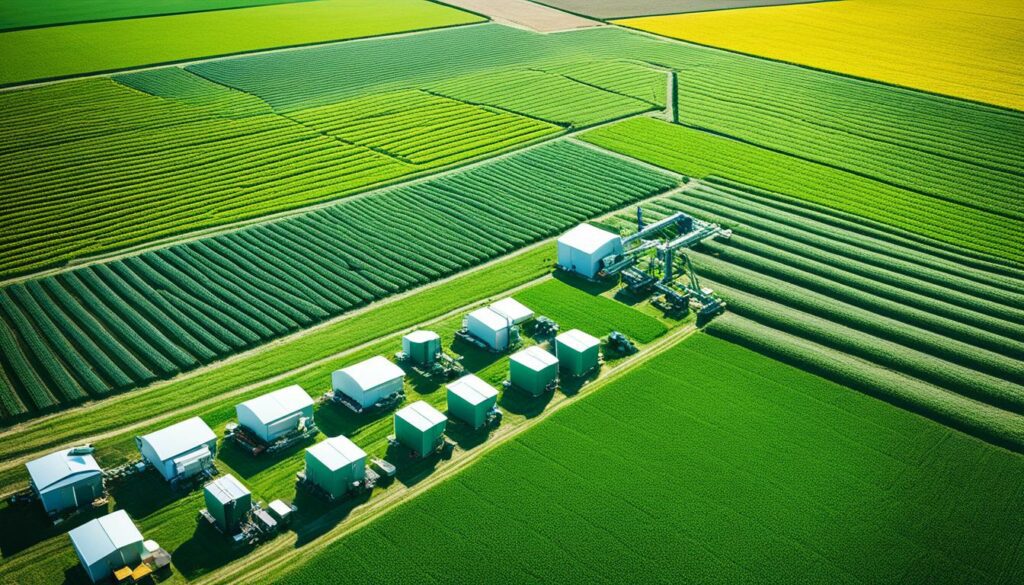
ERP systems give farm facts right away for making choices, helping get more done and waste less13. I’ve seen this as Farmer Patsy. It can change how you run a farm by giving key info fast. This includes looking at soil, bugs, water use, and guessing how much you’ll harvest. It means farms can do things well and in ways that last13.
These systems are also great for watching over animals and making them happier and more productive. This helps farms use what they have wisely and plan smarter13. As smart farming gets even smarter, these new clever tools will join in, working with ERP systems to set better goals for getting things done well and without hurting the earth.
The table below highlights some key features and benefits of agriculture ERP systems:
| Feature | Benefit |
|---|---|
| Resource Planning | Optimises resource use and streamlines processes |
| Production Tracking | Enhances operational efficiency |
| Supply Chain Management | Improves efficiency and productivity |
| Financial Management | Provides comprehensive oversight |
| Regulatory Compliance | Ensures adherence to standards and regulations |
AI is changing how we manage crops by making things smarter and more efficient. It uses high-tech methods to watch over the fields. It spots problems early and gives quick alerts, allowing farmers to act fast. Drones with AI technology also help. They predict how much crops will yield and check the health of the soil and plants. This means farmers know when and how to use pesticides better, saving money14.
Farmer Patsy says AI and robotics make farming better and greener. They help farms run smoother while caring for the environment.
AI is great at finding pests and diseases before they cause big damage. It looks through a lot of data to find problems early. This gets rid of pests without harming the environment14. The EU also wants to use fewer harmful chemicals in farming by 2030. It aims to grow crops more organically with help from these new technologies15.
Robots are changing how we pick and manage crops, making farming more efficient. They work in the fields, doing precise jobs without mistakes. This is good for the environment14. Some robots are even designed to remove weeds without harmful chemicals. This helps farms produce better crops while being kind to nature14.
Research shows that using robots and AI can make farms more productive. They help us grow better food by managing crops well15. This new way of farming is more efficient and sustainable.
Let’s see how AI and robotics in farming compare in different areas:
| Aspect | AI in Agriculture | Robotics |
|---|---|---|
| Pest and Disease Detection | Early identification and intervention | Enhanced precision in application |
| Labour Efficiency | Streamlined operations | Reduced labour costs |
| Environmental Impact | Optimised resource usage | Minimised herbicide use |
| Cost Savings | Reduced operational costs | Efficient and sustainable practices |
Using IoT in agriculture takes farming to a smarter level. It brings together IoT devices and precise farming. This mix boosts real-time tracking and quick decisions using analyzed data. Farmer Patsy says, “IoT lets farmers use data to guess how much to grow and cuts down on wasted resources. It’s changing the way we farm.”
IoT devices for real-time monitoring are changing how farming is done. They keep an eye on soil dampness, temperature, and the state of crops all the time. Farmers can act fast when things change. With IoT sensors and high-tech cameras from the ground, in space, or on drones, farming is evolving16.
Guessing how much to yield is crucial in today’s farming. IoT tools collect and crunch data for better forecasts. They can say when to harvest, what soil needs, and how to protect or water crops16.
The use of big data in farming is set to grow big, reaching $2.5 billion by 2028 with a 13.1% yearly rise18. By adding AI to IoT, smart suggestions for better farming are possible. This boosts yield and helps farms deal with climate change1617. With AI and data analysis, farmers make better choices, which helps the farm run well and supports the planet17.
Modern farming has been changed by advanced sensor technology. It has become a data-driven world that focuses on increased yield efficiency. These sensors are key in precision agriculture, providing detailed soil and plant monitoring for better crop care.
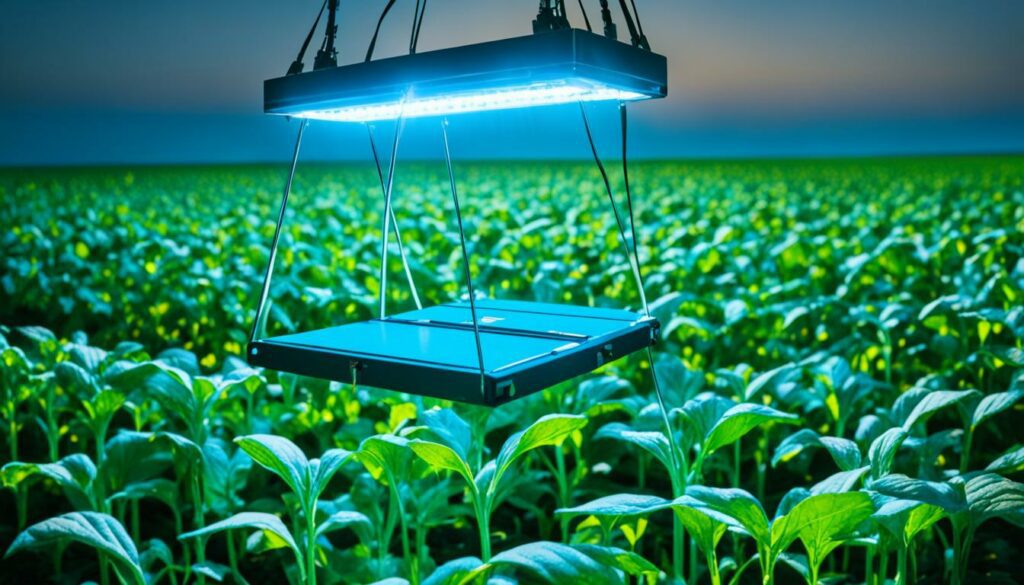
In today’s agriculture, soil and plant sensors are incredibly important. Sensors that measure soil moisture give accurate readings at different depths. This helps understand when crops are in need of water and what impact it might have on their growth19.
Images from hyperspectral and multispectral sensors can pinpoint issues like water stress or pests. Chlorophyll sensors, for instance, warn about drought stress in crops such as maize and soybeans19.
Farmer Patsy says, “Advanced sensor tech changes how we grow crops.” It gives us quick, important data that we couldn’t get before. For example, new paper-based sensors help detect when plants are stressed by too much salt in the soil19.
Weather modelling with advanced sensors is vital for farming today. It helps farmers plan when to water their crops or add nutrients. By using AI and ML with sensors, we can make sense of real-time weather data. This lets us see stress patterns in crops and forecast the weather19.
This mix of weather modelling and sensor data makes farming smarter and more in tune with nature. It means farmers use water more wisely, increasing their crop’s yield. By looking at leaf temperatures with infrared sensors, we get even more details for weather predictions19.
So, farmers make the most of their water and boost their crops by using weather forecasts and sensor info. It helps them take the right steps at the right time.
Smart technologies are changing how we manage irrigation, making it exact and sustainable. They use real-time data and smart systems. This way, they cut down on water waste and involve key techniques of precision agriculture.
Precision irrigation is key for providing water right when and where plants need it. Using technologies like machine learning and artificial intelligence, smart pivots can find problems before they happen. This means using water perfectly20.
Smart pivots also check their own condition in real-time. So, they can tell when they need maintenance. This stops machines from breaking down, boosting how well and fast things get done20. Farmer Patsy says, “Smart pivots have changed the game. I can irrigate with such precise control now.”
For further insights on the progress of smart irrigation, precision farming, and eco-friendly use of water, visit the irrigation system of the future.

One big plus of data analytics in farming is lowering risks. It can predict bad events such as droughts and pest attacks21. Farmer Patsy, a well-known expert, says this helps us protect our crops and our incomes. Using data to foresee problems makes our food supplies more secure and strong.
Using data, farmers can find out key things like what factors really affect crop growth. They also learn how to use resources better and keep up with market changes. This knowledge helps them come up with better plans for growing crops22.
GPS farming is great for putting crops exactly where they need to be. Farmers can treat each part of their field differently, which boosts crop quality and lowers spending24. Tractors with GNSS can work on their own very accurately, cutting down waste and making farm work better25. As Farmer Patsy says, “Using GNSS in farming changes how we plan fields, making our work more accurate and smart.”
GPS is also good for marking field edges, showing paths, and finding crop issues23. It’s a big help in watching how crops grow, so farmers can give fertilisers and insecticides exactly where they’re needed. This saves money and makes the most of resources24. With GPS, farmers can keep a closer eye on their crops and make choices that help them grow better24. GPS also makes it easier to do jobs like taking soil samples and spraying crops, making sure the right amount is used and less is wasted23.
So, using GPS and GNSS in farming makes a big difference. It helps with details, from planting just right to tracking how crops grow. This careful use of tech and data means better farming in many ways.
Farmers today are using new techniques to get more crops from their land. They mix old ways with new technology to grow better and more food. They start by making the perfect seedbed. It must be even, moist, and clean of weeds3. Adding the right amount of food for the plants, through soil-tested fertilisers, helps them grow strong3.
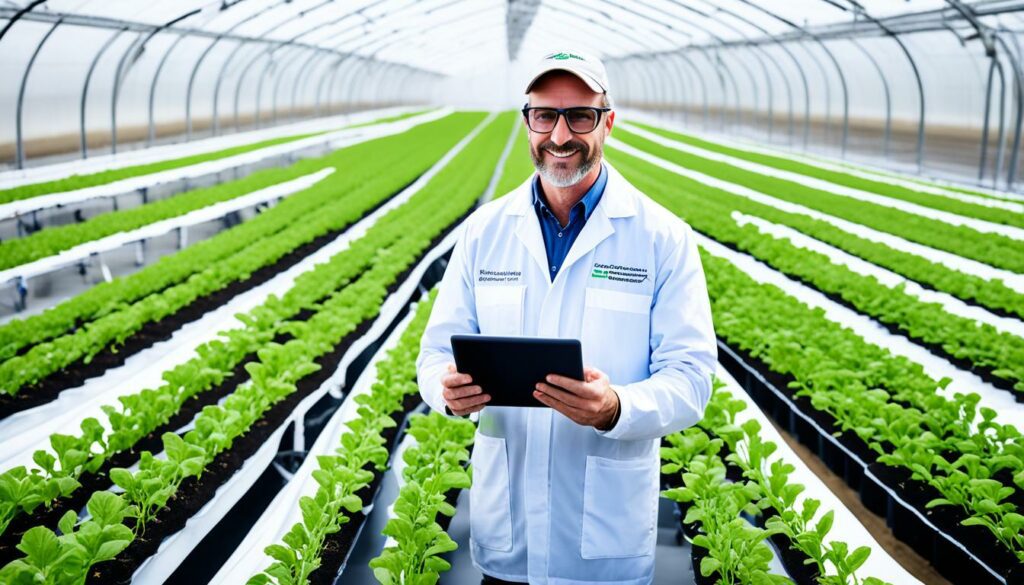
Switching the types of crops grown in a field helps keep the ground healthy. It also helps fight pests and diseases, making crops of higher quality26. Using many ways to control pests, such as machines and natural methods, is safer and cheaper for farmers3. Putting the right amounts of chemicals to kill pests is crucial to get the most out of the crops3.
Farmer Patsy says, “Mixing old farming ways with new tech is key for the land and our future. These methods help farmers get more food while keeping nature safe.”
Now, let’s compare different ways farmers manage their crops and show what each method does:
| Technique | Benefit | Data Source |
|---|---|---|
| Ideal Seedbed Preparation | Uniform growth, optimal soil moisture, and weed-free | 3 |
| Precision Irrigation | Improved water use efficiency | 3 |
| Reduced/No-Tillage | Increased soil carbon, better soil health | 3 |
| Crop Rotation | Enhanced soil fertility, pest, and disease suppression | 26 |
| IPM | Economical and safer pest control | 3 |
| Genetic Improvement | Increased crop yield | 27 |
In 2024, the world of farming has seen big changes thanks to precision agriculture. This new way of doing things has made a real difference. It’s not just about farming smarter. It’s also about showing others how to succeed using these new methods.
AeroFarms is a key player in this evolution. Since 2004, they’ve been perfecting vertical farming. By not using soil and instead relying on air to deliver nutrients, they have increased their crop output28. Gotham Greens is also making a big impact. They’re bringing fresh, local, and green produce to many cities in the U.S.28. Both these examples prove that new tech in farming works wonders.

LED lights, smart sensors, and automated systems are doing wonders for farming indoors. They’ve cut down on power use and made crops grow better28. AeroFarms and Gotham Greens are shining examples. They show us how farming can move forward, creating new jobs and chances for success28. As Farmer Patsy, I’ve witnessed how these tools can boost our harvest and keep our farms green.
Being a cutting-edge farmer comes with challenges. Consumers might not always understand our methods. Plus, the rules and costs can be tough28. But, these hurdles are met by farmers everywhere, not just in bustling cities. Even the countryside is benefiting, as seen in Nigeria’s huge increase in cereal production29.
My career in farming has taught me one thing. To succeed, we must always be ready to learn and change. It’s not just the farmers in big countries progressing. Take India, for example, which aims to produce much more milk29. These stories inspire us to keep going, despite the challenges. The investment in new farming styles promises a bright future28.
As someone who cares about farming’s future, I see great value in sharing success stories. They prove that what we do matters. And they guide us towards a future where farming is good for the planet while still being productive. Harnessing precision agriculture can lead us to a better, sustainable world of farming.
In 2024, agriculture is all about using smart farming to meet a growing world’s needs. We blend new tech with old methods to face issues head on. Precision agriculture leads the way, using live data and cutting-edge tools like GPS and IoT to farm smarter.
This year, we’re focusing on smart farming to make every harvest sustainable. Methods like no-till farming boost soil quality and increase crops3. Advanced irrigation systems save water, showing how important it is to protect our resources3. Farmer Patsy says using these smart tools helps us farm better while keeping our land healthy.
By mixing up how we grow things and controlling pests smartly, we make farming safer and more money-making3. Yet, in Europe, the growth of wheat and other cereals has slowed, pushing us to keep finding new ways to lead in farming30. We must keep pushing to grow more food every year, aiming at a big 70% increase before 205030.
Pairing these tactics with savvy ways to sell our goods means farms can thrive. Adding more crops and helping bees and other pollinators strengthens our farming model3. Farmer Patsy believes that using the best of both tech and tradition will make us farm well for many years, keeping food coming for all.
Precision agriculture uses technology to watch over crops and soil. This tech involves drones, satellites, and sensors. It helps farmers produce more while using less, thanks to smart, data-based choices.
CRISPR editing is changing farming by tweaking plant genes precisely. With this, crops can fight off diseases better and may have more nutrients. Leading groups, like the Innovative Genomics Institute, are pushing this forward.
Vertical farms save a lot of water and space by stacking crops. They grow food indoors all year. AeroFarms is a top player in this new way of farming.
Aquaponics and hydroponics grow food without soil and using little water. The systems combine fish with plants, feeding each other. Gotham Greens shows us that this tech can lead to green success.
AI and robots are making farming smarter and less manpower-intensive. By scanning for pests and handling weeds alone, they cut herbicide use. Blue River Technology is a leader in this eco-friendly shift.
IoT gadgets give farmers instant updates about their fields. They help with guessing yields and quick decision-making. This makes farming’s planning better and farm management greener.
High-tech sensors check soil, plants, and weather closely. They’re key for planning when to water and feed crops. This smart approach boosts harvests while being kind to our planet.
GPS and GNSS pinpoint where crops are and check how they’re growing. They help farmers do everything from planting to harvesting more efficiently. This means less waste and better use of farm resources.
Agricultural ERPs blend different farm tasks in one system. They connect things like money, growth plans, and rules. With everything in one place, farmers make smarter moves faster, making farming more profitable.
Smart irrigation uses data and devices to water crops only when needed. It cuts water use and fits well in places with dry climates. This is a key step towards a more sustainable way of farming.
Data crunching helps farmers figure out what’s really working on their farms. It guides choices that can boost crop numbers and make the most of resources. It’s a powerful tool for growing more effectively.
Many farmers using precision farming see big jumps in how much they produce. Their stories show the real benefits of using these high-tech methods. It proves these new ways of farming really work.